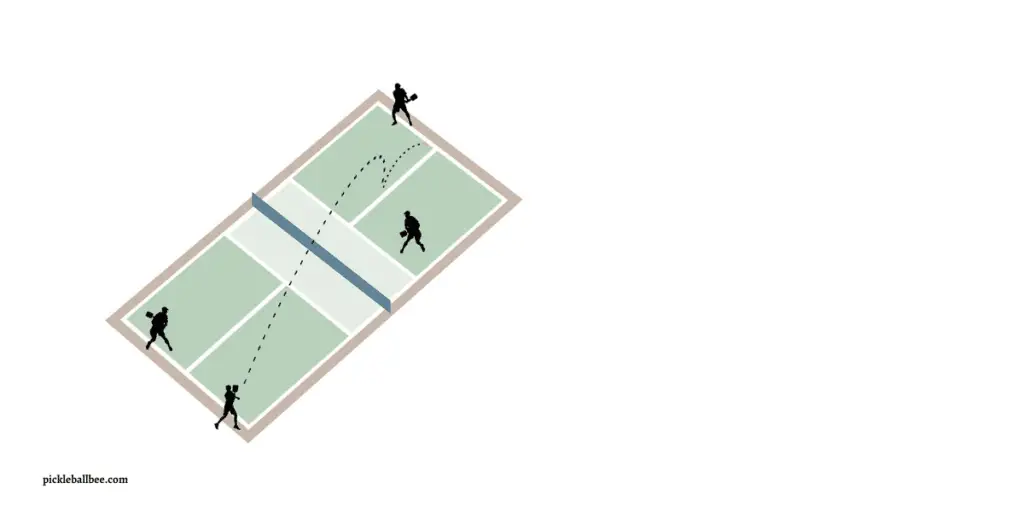
The sport of pickleball is a combination of badminton, tennis, and table tennis. Similar to tennis, but smaller in size, it’s played with a paddle and a plastic ball. It is crucial to understand the rules and strategies of any sport if you want to perform well. During a pickleball game, players often wonder when to switch sides. In this article, we will explore the factors that determine when to switch sides in pickleball.
When Do You Switch Sides In Pickleball?
In pickleball, you switch sides after completing a game or reaching a specific score (e.g., 6, 8, or 11 points) to ensure fairness. Time-based switches every few minutes maintain balance. Strategic side switching exploits opponents’ weaknesses, adapting to different court conditions. Effective communication with your partner enhances coordination. Overall, switching sides in pickleball is a tactical decision based on score, time, and game situation, influencing the outcome and creating opportunities for success.
Table of Contents
The Concept Of Sides In Pickleball

In pickleball, the court is divided into two sides, namely the right side and the left side. Each player or team starts the game on one side of the court, and they will continue playing on that side until a switch occurs. Switching sides typically happens after the completion of each game or when specific conditions are met.
Importance of Switching Sides
Switching sides in pickleball serves multiple purposes. Firstly, it ensures fairness by accounting for any discrepancies in court conditions, such as wind or sun direction. Secondly, it helps players adapt to different factors that may affect gameplay, such as changes in lighting or surface conditions. Lastly, switching sides allows players to strategize and take advantage of the court dimensions to improve their chances of winning.
How do you know when to switch sides in pickleball?

Knowing when to switch sides in pickleball involves considering the following points:
- Completion of a game or reaching a specific score: Switch sides after finishing a game or when the score reaches a predetermined value, commonly set at 6, 8, or 11 points. This ensures fairness and equal opportunities for both players or teams.
- Time-based switches: Implement time-based switches every few minutes, such as every 10 minutes. This helps maintain fairness and prevents any perceived advantages from playing on one side for an extended period.
- Strategic decision-making: Evaluate your opponents’ weaknesses and playing style. Strategically switch sides to exploit their vulnerabilities or counter their strategies, aiming to put them in uncomfortable positions and gain an advantage.
- Adaptation to court conditions: Different factors like wind, lighting, or surface conditions can impact gameplay. Switch sides to adapt to these changing court conditions, optimizing your performance and adjusting to the dynamics of the match.
- Effective communication with your partner: Coordinate with your partner when deciding to switch sides. Discuss the decision, assess the game situation together, and strategize as a team. Clear communication ensures a synchronized approach and enhances overall performance.
By considering these points, players can determine the appropriate moments to switch sides in pickleball, maximizing their strategic advantage and optimizing their gameplay.
How do you determine which side to serve from in pickleball?
The side to serve from in pickleball is determined by a combination of factors. In doubles play, the team that wins the coin toss or rally typically gets to choose the side they want to serve from or decide who serves first. Both teams switch sides after the first server goes down. Throughout the game, the serving team continues to serve from the right-hand side of the court until they lose a point, at which point they switch to the left-hand side. This rotation of sides ensures fairness and equal opportunities for both teams.
Factors Influencing the Decision to Switch Sides in Pickleball
The decision to switch sides in pickleball can be influenced by factors such as the score, time, and tactical considerations. Score-based switches occur when players reach a predetermined score, ensuring equal opportunities on each side. Time-based switches, like switching every 10 minutes, maintain fairness. Tactical switches involve exploiting opponents’ weaknesses or countering their playing style. For instance, players may switch sides to force opponents into uncomfortable positions. These factors collectively impact when to switch sides in pickleball.
Can You switch sides with your partner in pickleball?
Yes, in pickleball doubles play, you can switch sides with your partner. After each side-out, where the serving team loses the point, both players on the serving team switch sides. This allows for better positioning on the court and ensures equal opportunities for both players to serve and receive. By switching sides with your partner, you can strategize and adapt to different situations during the game, maximizing your teamwork and effectiveness on the court.
Common Misconceptions About Switching Sides
There are a few common misconceptions about switching sides in pickleball that should be addressed:
- Switching sides is only for advanced players: Switching sides is a strategy that can benefit players of all skill levels. It helps level the playing field and provides opportunities to adjust to different court conditions.
- Switching sides disrupts the flow of the game: While switching sides may briefly interrupt the rhythm, it can also help break your opponents’ momentum and create new opportunities for success.
- Switching sides is random: Side switching is a tactical decision that should be based on factors such as score, time, and game situation. It is not a random occurrence.

Conclusion
In the end, Switching sides in pickleball is an important aspect of the game that can influence the outcome of a match. By understanding the factors that determine when to switch sides and implementing effective strategies, players can optimize their performance and increase their chances of winning.
FAQs:
-
Is it OK to Switch Hands In Pickleball?
Yes, it is generally acceptable to switch hands in pickleball. Players are allowed to switch their paddle from one hand to the other during a point if needed. However, it’s important to do so smoothly and without interfering with the opponent. While not a common practice, switching hands can be useful for reaching shots on the opposite side of the body or adding variety to the game.
-
Can You Talk During Pickleball?
Yes, communication during pickleball is encouraged and allowed. Players can talk to their partners to coordinate strategies, call out shot selections, and provide encouragement. However, it is important to maintain good sportsmanship and avoid distracting or disrupting opponents. Brief and relevant communication is typically preferred to ensure a focused and enjoyable game for everyone involved.
-
Does Switching Sides Give Advantage to Players?
Yes, switching sides in pickleball can provide advantages to players, such as adapting to different conditions, exploiting opponents’ weaknesses, and creating a fair playing field.
-
Do Beginners Need To switch Sides In Pickleball?
Yes, switching sides is beneficial for players of all skill levels as it helps them adjust to different court conditions and improve their overall gameplay.
“Switching sides in pickleball: Where strategy meets fairness, adapting to the game’s rhythm and unlocking new opportunities for success.”


